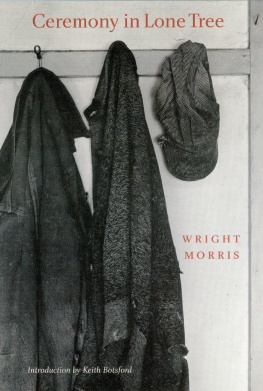
Other titles by Wright Morris available in Bison Books editions
THE HOME PLACE
PLAINS SONG
FOR FEMALE VOICES

1959, 1960 by Wright Morris
Reprinted by arrangementd with Josephine Morris
Introduction 2001 by the University of Nebraska Press
All rights reserved
First Bison Books printing: 1973
Library of Congress Cataloging-in-Publication Data
Morris, Wright, 1910
Ceremony in Lone Tree / Wright Morris; introduction by
Keith Botsford.
p. cm.
ISBN 0-8032-8276-1 (pbk.: alk. paper)
1. Aged menFiction. 2. NebraskaFiction. 3. Birthdays
Fiction. 4. Ghost townsFiction. 5. Family
reunionsFiction. I. Title.
PS3525.07475 C4 2001
813.52dc21 2001027957.
The publisher does not have any control over and does not assume any responsibility for author or third-party websites or their content.
For Jo
INTRODUCTION
Keith Botsford
The benchmark of any real writer is voice. That voice must be identifiably unique to the writer, so that were you to lay out twenty or thirty pages from as many authors, you should be able to spot that voice. Countless mazurkas exist, but only Chopins are unique. So it is with writers from Americas great center (our Middle Kingdom), many of whom moved East. After Willa Cather, Morris sings truest. Because of his voice.
Im not sure that this unique voice or its Great Plains context can be pinned down. I fear the professors cant help us; not that there has been an almighty rush to explicate Morris, but even good ones might give us such sensible advice as, Read him and youll see. For isnt it a mite obvious to reduce Morris to nostalgia, to the region which is his stage, or to the photography by which many first came to know him? Does it help to pin him with epithets like Bard of the Prairies? Readers can figure out that much for themselves. A lot of writers before Morris, and a few that came after him, have attempted the same thing he does, with varying degrees of success. Few, I think, have made so much dance on so little.
Here readers have their chance to work out what is unique about Morris, for Ceremony in Lone Tree is quintessential Morris. All the elements of his art are here, pure and concentrated: the basic unities of place and time. Everything tends toward Scanlons ninetieth birthday in Lone Tree: the way Morris gathers together time in one complex referential bundle, so that past, present, and future all play their roles, bound together like a sheaf of wheat; the awareness of other bounds, of befores and afters, of elsewheres; the magisterial control of detail, in which, in true frugal fashion, nothing is wasted; and the weight and solidity of the prose, its laconicism, its economy, its reverberations.
Morriss books are not longmany are no more than novellasbut they are to be read slowly, even in an age of vanishing spans of attention. In him, this is not shortness of breath but immense concentration. Curiously, this shorter form of fiction has always served particularly well in dealing with characters whose lives are essentially nonverbal, whose field of vision (to use a Morris trope) is so specific to place. They often rely for their effect on their resonance, on what is not said or what did not happen.
Blackbird, the Indian of A Life, has little to say and, at the critical moment, nothing at all. But he slices the old mans wrist with the sharp edge of a tin can. Which is exactly what Morriss prose does. In Ceremony, a Bomb that doesnt go off is metaphorically present throughout the story. That takes just a few lines:
Mr. Boyd, said the woman, there was no bomb, so I didnt wake you up.
Maybe next time, he said.
You cant say how Morris does it, because if it werent for what went before and comes after, the shaggy-dog Bomb wouldnt matter. Its the weight he applies to everything that counts. Gravitas, if you likethough Morris can be terribly funny. Yet who says the comic cant be terrible? Boyd and the waif, Big Daddy and Daughter, are the jokers in this pack, the serious jokers. Shes so small (she used what weight she had to lean on the crank) that when they meet at the one-armed bandit, Boyd is reminded of a bird in the animal fables, neither young nor old. Thats how they begin. She pops out her contact lenses. Together they can joke away the Scanlon clan, the old man (He was for everybody who hated something or was against something, since that was how he felt himself), and his offspring in generations.
The realist technique shows people and things as they are. Bits and pieces of something called reality are assembled and ordered in a narration. Thats Zola, thats John Dos Passos, and thats a big part of Dreiser. But its not WrightMorris, who is more like an alembic, in whom the vaporous properties of reality are condensed and seen plain.
Something similar happens in Proust: in the madeleine, in Balbec, and in the operations of time. You may remember in Proust Bergottes rapture, as he dies, at a patch of yellow in Vermeers View of Delft. Same thing: much has been made of very little, but it only makes sense if, when you look at that yellow, or the blood streaming from the old mans wrist, the Bomb, or an old revolver that goes off, youre concerned with ultimates, with essence, with residue.
Unfortunately for Morris and his reputation, we live in a solipsistic age. Who wants to inquire beyond the all-encompassing Self? Ultimates have dropped off the shelf: Pilgrims Progress, all Dante beyond the sexy bits in the Inferno, Montaignewith whom Morris shares so much sangfroid about the real world. Whats left is the illusion of reality, whats sexy about it, what the Self can see of itin Morriss case, ersatz substitutes: the Pretty Horses, Sam Shepherd, the brothers Cohn.
But again, its too easy to say that Morriss ultimates are those of the desert, those arid places from which our monotheisms arose; that he deals with ultimates because the here and now has nothing to show for its being, just pump handles, worn shoes, dry grass, and a derelict people. I think thats to read Morris as though he were one-dimensional, as though that were all he had to say. Thats the risk he took as a writer: to make his particular place universal. The lives of Morriss people should be read as what the crowds drawn to the Bomb came to see: Terrible as it was, it was also a wonderful sight. There was this flash, then this pillar of fire went up and up, like a rabbits ear. Thats what Morris does in Ceremony.
You better be up for it, she said, and after his name in the register she added:
WAKE BEFORE BOMB
Thats what Ceremony is about.
Writers who look to ultimatesfundamentalsshare certain traits. A number of them, for instance, are literary geologists. To us, rocks look alike; to them, not. Consider Charles Dougthy on Arabia, or Euclides da Cunha, who was a surveyor and wrote one of the great unknown texts of the twentieth century, Os Sertoes (translated in the 1930s by Samuel Putnam as Rebellion in the Backlands). Such writers want to know how rocks, or people-as-rocks, were formed. They are writers of the interior of big countries. The interiors, as the French historian Fernand Braudel says, are islands or fastnesses. They are not like the coasts, where everything, races and languages, gets mixed up as the result of commerce. In the great Interior (which is always mysterious, violent, and unadorned), the Henri Taine imperativesrace, milieu, momentmake it possible to read people as too humble, too anonymous in their destinies, and too evident. Islands can be studied completely. The story of each individual is the story of all, since all are conditioned by the same reality.
Next page












